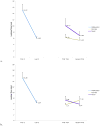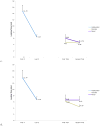The long and the short of it: on the nature and origin of functional overlap between representations of space and time - PubMed (original) (raw)
The long and the short of it: on the nature and origin of functional overlap between representations of space and time
Mahesh Srinivasan et al. Cognition. 2010 Aug.
Abstract
When we describe time, we often use the language of space (The movie was long; The deadline is approaching). Experiments 1-3 asked whether-as patterns in language suggest-a structural similarity between representations of spatial length and temporal duration is easier to access than one between length and other dimensions of experience, such as loudness. Adult participants were shown pairings of lines of different length with tones of different duration (Experiment 1) or tones of different loudness (Experiment 2). The length of the lines and duration or loudness of the tones was either positively or negatively correlated. Participants were better able to bind particular lengths and durations when they were positively correlated than when they were not, a pattern not observed for pairings of lengths and tone amplitudes, even after controlling for the presence of visual cues to duration in Experiment 1 (Experiment 3). This suggests that representations of length and duration may functionally overlap to a greater extent than representations of length and loudness. Experiments 4 and 5 asked whether experience with and mastery of words like long and short-which can flexibly refer to both space and time-itself creates this privileged relationship. Nine-month-old infants, like adults, were better able to bind representations of particular lengths and durations when these were positively correlated (Experiment 4), and failed to show this pattern for pairings of lengths and tone amplitudes (Experiment 5). We conclude that the functional overlap between representations of length and duration does not result from a metaphoric construction processes mediated by learning to flexibly use words such as long and short. We suggest instead that it may reflect an evolutionary recycling of spatial representations for more general purposes.
Copyright (c) 2010 Elsevier B.V. All rights reserved.
Figures
Figure 1
Congruent and incongruent pairings of line length and tone duration presented in Experiment 1. Asterisked pairings were presented in test to both groups
Figure 2
Results from Experiment 1, by test trial type, difficulty, and group
Figure 3
Congruent and incongruent pairings of line length and tone loudness presented in Experiment 2. Asterisked pairings were presented in test to both groups
Figure 4
Results from Experiment 2, by test trial type, difficulty, and group
Figure 5
Results from Experiment 3, by test trial type, difficulty, and group
Figure 6
Congruent and incongruent pairings of caterpillar length and tone duration presented in Experiment 4. Asterisked pairings were presented in test to both groups
Figure 7
Full habituation and test data from Experiment 4 for the a) congruent group and b) the incongruent group.
Figure 8
Congruent and incongruent pairings of caterpillar length and tone loudness presented in Experiment 5. Asterisked pairings were presented in test to both groups
Figure 9
Full habituation and test data from Experiment 5 for the c) congruent group and d) the incongruent group.
Similar articles
- Time in the mind: using space to think about time.
Casasanto D, Boroditsky L. Casasanto D, et al. Cognition. 2008 Feb;106(2):579-93. doi: 10.1016/j.cognition.2007.03.004. Epub 2007 May 16. Cognition. 2008. PMID: 17509553 - Left-right coding of past and future in language: the mental timeline during sentence processing.
Ulrich R, Maienborn C. Ulrich R, et al. Cognition. 2010 Nov;117(2):126-38. doi: 10.1016/j.cognition.2010.08.001. Epub 2010 Sep 17. Cognition. 2010. PMID: 20850112 - Priming the mental time-line: effects of modality and processing mode.
Rolke B, Fernández SR, Schmid M, Walker M, Lachmair M, López JJ, Hervás G, Vázquez C. Rolke B, et al. Cogn Process. 2013 Aug;14(3):231-44. doi: 10.1007/s10339-013-0537-5. Epub 2013 Jan 24. Cogn Process. 2013. PMID: 23344530 - Perceptual assimilation of lexical tone: the roles of language experience and visual information.
Reid A, Burnham D, Kasisopa B, Reilly R, Attina V, Rattanasone NX, Best CT. Reid A, et al. Atten Percept Psychophys. 2015 Feb;77(2):571-91. doi: 10.3758/s13414-014-0791-3. Atten Percept Psychophys. 2015. PMID: 25465395 Free PMC article. - Spatial-temporal interactions in the human brain.
Oliveri M, Koch G, Caltagirone C. Oliveri M, et al. Exp Brain Res. 2009 Jun;195(4):489-97. doi: 10.1007/s00221-009-1834-1. Epub 2009 May 21. Exp Brain Res. 2009. PMID: 19458940 Review.
Cited by
- Decomposing geographical judgments into spatial, temporal and linguistic components.
Gatti D, Anceresi G, Marelli M, Vecchi T, Rinaldi L. Gatti D, et al. Psychol Res. 2024 Jul;88(5):1590-1601. doi: 10.1007/s00426-024-01980-7. Epub 2024 Jun 5. Psychol Res. 2024. PMID: 38836875 Free PMC article. - Memory capacity as the core mechanism of the development of space-time interferences in children.
Hallez Q, Balcı F. Hallez Q, et al. Sci Rep. 2024 May 6;14(1):10377. doi: 10.1038/s41598-024-61018-1. Sci Rep. 2024. PMID: 38710784 Free PMC article. - Everything is Infinite: Children's Beliefs About Endless Space, Time, and Number.
Sullivan J, Cramer-Benjamin S, Alvarez J, Barner D. Sullivan J, et al. Open Mind (Camb). 2023 Sep 20;7:715-731. doi: 10.1162/opmi_a_00104. eCollection 2023. Open Mind (Camb). 2023. PMID: 37840760 Free PMC article. - Gradient Organization of Space, Time, and Numbers in the Brain: A Meta-analysis of Neuroimaging Studies.
Cona G, Wiener M, Allegrini F, Scarpazza C. Cona G, et al. Neuropsychol Rev. 2024 Sep;34(3):721-737. doi: 10.1007/s11065-023-09609-z. Epub 2023 Aug 18. Neuropsychol Rev. 2024. PMID: 37594695 Free PMC article. - Language as a mechanism for reasoning about possibilities.
Grigoroglou M, Ganea PA. Grigoroglou M, et al. Philos Trans R Soc Lond B Biol Sci. 2022 Dec 19;377(1866):20210334. doi: 10.1098/rstb.2021.0334. Epub 2022 Oct 31. Philos Trans R Soc Lond B Biol Sci. 2022. PMID: 36314149 Free PMC article. Review.
References
- Alverson H. Semantics and experience: Universal metaphors of time in English, Mandarin, Hindi, and Sesotho. Baltimore: Johns Hopkins University Press; 1994.
- Banks WP, Clark HH, Lucy P. The locus of the semantic congruity effect in comparative judgments. Journal of Experimental Psychology. 1975;104(1):35–47.
- Barner D, Snedeker J. Compositionality and statistics in adjective acquisition: 4- year-olds interpret tall and short based on the size distributions of the novel noun referents. Child Development. 2008;79(3):594–608. - PubMed
- Berch DB, Foley EJ, Hill RJ, Ryan PM. Extracting parity and magnitude from Arabic numberals: Developmental changes in number processing and mental representation. Journal of Experimental Child Psychology. 1999;74:286–308. - PubMed
- Bjoertomt O, Cowey A, Walsh V. Spatial neglect in near and far space investigated by repetitive transcranial magnetic stimulation. Brain. 2002;125(9):2012–22. - PubMed








